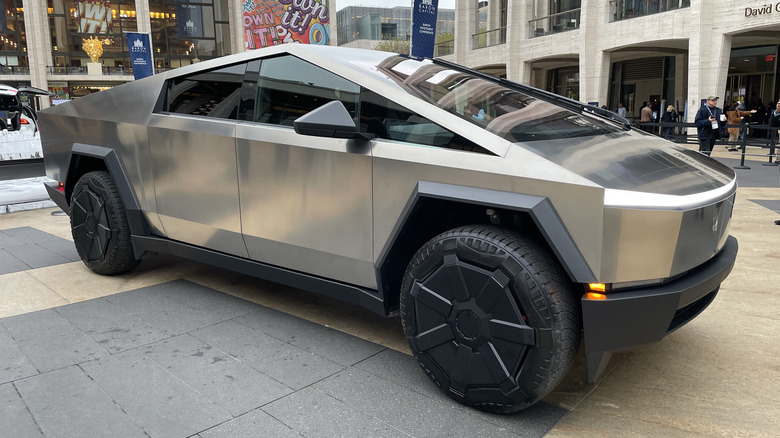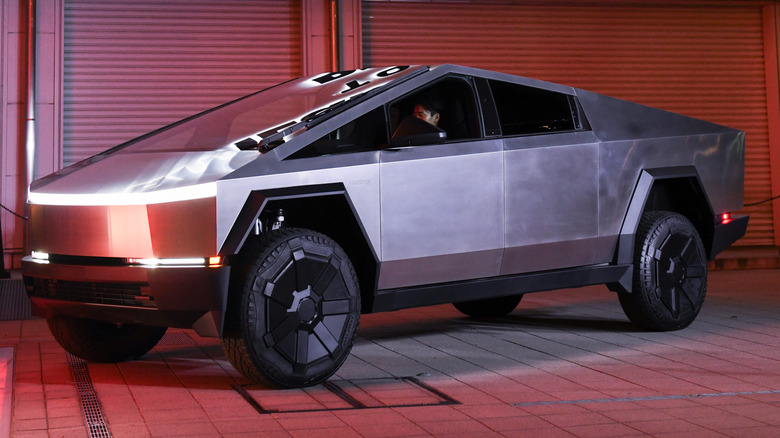Is The Telsa Cybertruck's Stainless Steel Body Vulnerable To Rust?
Aside from its questionably charismatic angular design, one of the most heavily marketed traits of the Tesla Cybertruck is the machine's hulking build. But it seems even Tesla, despite all its engineering acumen, can't beat the force of nature that is rusting. It has only been a few weeks since Tesla began the Cybertruck deliveries, but multiple owners have already posted their run-ins with what appears to be corrosion building up on the Cybertruck.
Tesla says its electric truck relies on an exoskeleton of ultra-hard stainless steel that allows it to "reduce dents, damage, and long-term corrosion." It, however, appears that claims of long-term corrosion resistance may not be entirely true, at least if you are moving around in the Cybertruck in its pristine state without any coat over it. A month ago, one owner shared an image of the Cybertruck showing visible signs of corrosion appearing in the form of small specks instead of patchy growth.
"Seems like it's much more prominent on the top metal that rises above the truck bed moreso than anywhere else, but the spots are definitely everywhere in the metal," the owner wrote in an update. The owner claimed that they got in touch with a Tesla representative at the service center and were told that the company has a guideline for fixing the issue, but currently, they haven't supplied the right tools and haven't delivered such repair before. The owner was told that the service center would get in touch when the right tools and directions were made available to them to fix the corrosion problem.
What's the reason?
The Reddit post cited above isn't the sole report of its kind. "Just picked up my Cybertruck today. The advisor specifically mentioned the cybertrucks develop orange rust marks in the rain and that required the vehicle to be buffed out," claims a post on the Cybertruck Owners Club forum. "I picked it up in Dublin yesterday (Thursday) it was pouring raining, drove it up to Sacramento and there's a bunch of tiny orange specks and a few water spots. The orange dots aren't huge, they're very tiny but they're apparent," says another post on the Cybertruck Owner Club forum.
Now, Tesla has yet to offer an official explanation as to why this is happening, but there are multiple theories floating around that claim to offer a scientific explanation. Some say it is due to rail-road dust or carbon-based particulate matter, while some say it is due to the inherent material nature of the particular stainless steel that Tesla formulated for the Cybertruck.
According to the Society of Automotive Engineers, which designates the SAE steel grades, the proprietary 301-series stainless steel alloy used for the Cybertruck's heavy exoskeleton is likely a lead-based austenitic material. Musk has described it as ultra-hard 30X cold-rolled stainless steel; however, we don't know the exact chemical composition. Some say Tesla went with a composition that allowed it to maximize the strength and longevity of the alloy instead of using a mix that includes elements like Molybdenum or Chromium. Both these metals are known to improve the corrosion resistance of steel.
What Tesla has to say?
Justin Demaree, who runs the Bearded Tesla Guy channel on YouTube, in the video above, is talking about the corrosion reports on the Cybertruck. Demaree notes that the tiny specs and dots are signs of surface-level contamination and can easily be cleaned using cleaner products that are easily available in the market.
"To my surprise, indeed there are specs of oxidation everywhere on his Cybertruck. This pattern is consistent and littered across every panel on his Cybertruck," he wrote in the description of his YouTube video. He adds that the specks of rusting are not due to the steel's material deteriorating, but more likely due to the accumulation of external metallic particles.
The lead of the Cybertruck project at Tesla, Wes Morril, also mentioned that it is actually external metallic particles that sit on the Cybertruck's surface and chemically react with the steel, taking the appearance of corrosion marks and patches. He added that cleaning likely won't require a visit to a Tesla service center and can be done at home without requiring any specialized tools or proprietary chemicals.
"Bar Keeper's Friend used here works well, citrisurf77 can also loosen the deposit and simply wipe it off. If anything stubborn use a blue non-scratch Scotch Brite pad as it won't leave any marks on the metal," Morril wrote in a post on X, formerly known as Twitter. Tesla CEO Elon Musk also seconded Morrill's explanation with a curt "yeah" on X.
The user manual fix
"Clean it anytime or don't if it doesn't bother you. It's not the base metal. The specs are about the size of the pin of a pinhead," the Tesla engineer wrote in another post. Now, Tesla's official website hasn't shared the Cybertruck user manual yet, but copies and segments from it appeared online a while ago. An image shared on Reddit, which apparently shows the "Cleaning" portion of the Cybertruck user manual, mentions that "it is normal for the stainless steel exterior to mature over time," adding that natural aging can change the reflective properties of the material.
However, it also warns buyers to immediately remove any corrosive material that lands on the surface, including "grease, oil, bird droppings, tree resin, dead insects, tar spots, road salt, industrial fallout, etc." Depending on the kind of material, Tesla advises users to clean it with denatured alcohol, water, or mild non-detergent soap.
The company also advises against using car shampoos or cleaning chemicals that contain hydroxide, alkaline, caustic, or acidic ingredients. Tesla says such chemicals can lead to discoloration or damage to external components, neither of which is covered under warranty. SlashGear has reached out to Tesla for more clarity into the rusting reports and will update this story as we get a response from a spokesperson.


